|
|
|
Sort Order |
|
|
|
Items / Page
|
|
|
|
|
|
|
| Srl | Item |
| 1 |
ID:
124113
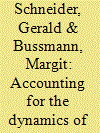

|
|
|
|
|
| Publication |
2013.
|
| Summary/Abstract |
This article presents the Konstanz One-Sided Violence Event Dataset (KOSVED) which allows researchers to study the dynamics of civilian abuse in 17 civil wars. The dataset provides, based on a multitude of sources, detailed information on the number of civilians killed or harmed by government or rebel troops. Where information is available, KOSVED also documents the dates of these events as well as the identities of the perpetrators and the means used in terrorizing the civilian population. The authors argue that the content analysis of news reports offers relatively accurate figures on those events that the perpetrators cannot hide from the public and that receive prominent media attention. Presumably, such information motivates potential short-term retaliatory acts by the group that has been the target of one-sided violence. The analysis suggests that, over the course of a conflict, almost all actors attack unarmed citizens, although to radically different degrees and relying on different means.
|
|
|
|
|
|
|
|
|
|
|
|
|
|
|
|
| 2 |
ID:
124107
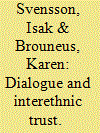

|
|
|
|
|
| Publication |
2013.
|
| Summary/Abstract |
The growing field of peacebuilding has tried to mitigate interethnic conflicts by creating various sorts of dialogue programs, aiming to build social bonds and bridges between individuals from groups with a history of violent interaction. Yet, little is known of the effect of dialogue initiatives on interethnic relations and peacebuilding. Previous research on dialogue programs has suffered from the serious problem of selection bias: in other words, by not having comparable control groups it has not been possible to separate selection effects (that a program attracts certain types of people) from process effects (that programs have an effect on people). The present study is the first to examine the effects of a dialogue process in a context of political tension and ethnic violence through a randomized field experiment, thereby eliminating this problem. Using a stratified randomization process, participants were selected to a two-term Sustained Dialogue program at Addis Ababa University, Ethiopia, in 2009-10. Immediately following the dialogue intervention, an attitudinal survey and a behavioral trust game were conducted with a group of 716 participants and non-participants. We found that the program had a positive effect on participants' attitudes: it worked for decreasing mistrust and increasing the level of trust between people of different ethnic origins. Concurrently, however, participation in the dialogue program increased the sense of importance of ethnic identities as well as the perception of being ethnically discriminated - a somewhat counter-intuitive finding. Participation in dialogue processes had no significant effect on game behavior: participants in Sustained Dialogue were neither more trusting nor trustworthy than non-participants. This study shows the fruitfulness of randomized field-experiments in the area of peace and conflict research and finishes by identifying some important paths for future research.
|
|
|
|
|
|
|
|
|
|
|
|
|
|
|
|
| 3 |
ID:
124109


|
|
|
|
|
| Publication |
2013.
|
| Summary/Abstract |
A rich literature addresses how a state's capabilities, its desire to aid or exploit a warring neighbor, and its alliance commitments determine whether or not the state joins an ongoing conflict. However, an important geopolitical consideration - proximity to the location of the ongoing conflict - has yet to be examined. The authors argue that states are more likely to join conflicts that occur close to their territories than conflicts that are located at a greater distance, and that accounts that do not pay attention to this distance are incomplete. Proximity to the location of an ongoing conflict affects the opportunity for a state to join (by decreasing costs), while also affecting the state's willingness to join (by increasing the potential threat to the state's security). A series of statistical models provide evidence for the authors' claims: a state's opportunity to join and its willingness to aid or exploit a neighbor in conflict, or to fulfill its alliance commitments, are each conditioned by its proximity to the location of the conflict. This conditioning effect of dispute location is important because it helps account for cases that appear to contradict the expectations of existing arguments regarding capabilities, contiguity, and alliances - such as when weak, non-contiguous, and non-allied states join ongoing conflicts and strong, contiguous, and allied states do not join.
|
|
|
|
|
|
|
|
|
|
|
|
|
|
|
|
| 4 |
ID:
124112
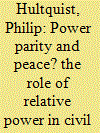

|
|
|
|
|
| Publication |
2013.
|
| Summary/Abstract |
Theories of civil war highlight how relative power affects conflict onset, dynamics, strategy, outcome, and duration. Yet most studies of civil war have not been able to capture rebel power adequately and often rely on national-level characteristics to infer relative power distributions. This study addresses this shortcoming by using a troop strength measure to test arguments about how relative power affects the likelihood of civil conflict settlement. Drawing on the international crisis bargaining literature, while noting the inherent differences between interstate and intrastate conflicts, this study argues that the condition of power parity increases the likelihood of negotiated settlement and ceasefire. Weak rebels are unable to achieve concessions through negotiation since governments view them as minor threats. Yet governments have difficulty defeating weak rebels due to an emphasis on guerrilla warfare. On the other end of the spectrum, rebels that are superior to the government in strength are unlikely to settle given their power advantage. Strong rebels that can rival the strength of the government (i.e. they are near parity) can exact more concessions because fighting at parity exposes information about how long each side can hold out while escalating the costs of war, giving each side a greater incentive to negotiate and eventually seek a ceasefire or peace agreement. This argument is supported using data on 112 dyads in the post-Cold War period.
|
|
|
|
|
|
|
|
|
|
|
|
|
|
|
|
| 5 |
ID:
124111
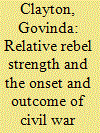

|
|
|
|
|
| Publication |
2013.
|
| Summary/Abstract |
To what extent does the relative strength of a rebel movement impact upon the likelihood of a peace settlement in civil conflict? This article argues that relatively stronger rebels are more likely to overcome the strategic bargaining problems that can prevent the resolution of war. Relatively strong insurgents are better equipped to significantly challenge core government interests and fundamentally threaten the survival of a regime. The incumbent's fear of future violence therefore makes mediation more likely to be undertaken in high-stakes conflicts between states and strong rebel groups. Relatively strong insurgencies are also those with the greatest leverage to negotiate enforcement mechanisms and the best equipped to defend themselves in the event that the government reneges on an agreement. This reduces the scale of the commitment problem and increases the probability of relatively strong rebel groups agreeing to a settlement with an incumbent. This argument is tested using dyadic data that capture the relative position of insurgents in civil war from 1946 to 2004. This represents an important methodological shift within the mediation literature, which has in the past largely relied upon aggregate country-level data. The results suggest that relatively stronger insurgents are more likely to force the state to open a mediation process and eventually concede some form of settlement. This is further evidence of the need to capture the dyadic relations between actors with fine-grained disaggregated data.
|
|
|
|
|
|
|
|
|
|
|
|
|
|
|
|
| 6 |
ID:
124106
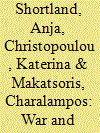

|
|
|
|
|
| Publication |
2013.
|
| Summary/Abstract |
The literature on war economies argues that prolonged civil wars have an economic logic: certain groups may obtain material gains from committing acts of violence and hence resist peacebuilding efforts. Objective tests of these predictions have so far been limited, as corruption and conflict prevent the collection of reliable economic data on the ground. Remote sensing and Geographic Information Science techniques enable us to overcome these problems of terrestrial data collection. Electricity consumption manifested as night-time light emissions recorded in satellite images is proposed as a proxy for changes in disposable income in Somalia's cities. The nightlight images provide striking illustrations of economic decline and recovery and clearly show the contrast between the stable regions of Northern Somalia and the chaos and anarchy of Southern Somalia. Based on geospatial analyses of settlement patterns in Somali cities, we argue that specific metrics of light output can be used to proxy for the incomes of different social groups. We use geo-coded conflict event data to analyze the economic impact of conflict on local light output and therefore incomes. We find a significant peace dividend for poorer households located at the margins of cities, which benefit both from local stability and more peaceful conditions in the country as a whole. By contrast, the central business districts are relatively well insulated from the effects of local conflict, and violence in Mogadishu has positive effects on light output from cities where humanitarian aid agencies are located. Future peace initiatives need to confront these economic incentives for continued conflict and state failure in Somalia.
|
|
|
|
|
|
|
|
|
|
|
|
|
|
|
|
| 7 |
ID:
124108
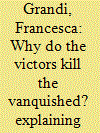

|
|
|
|
|
| Publication |
2013.
|
| Summary/Abstract |
When World War II ended in Italy, the violence did not. During the following year, about 10,000 individuals were summarily executed. Why does armed violence continue after a war's end? Why do the victors kill the vanquished enemies? Why do they do so in certain places but not in others? We do not have sufficiently satisfying answers to these questions. The literature makes sense of violence if it happens during or preceding an armed conflict, but overlooks it when it occurs after the war is over. We need to fill this gap. Not only does post-conflict violence merit consideration as a phenomenon in itself but also it is crucial to understand postwar politics. The structured comparison of two provinces in Italy at the end of WWII shows that existing explanations cannot fully account for the spatial variation of the killings there. I offer an alternative argument: post-conflict violence aims to influence a country's political future. In post-WWII Italy, the strategic calculations and the political preferences of former resistance combatants, combined with the legacy of the past war, determined the variation in the killings. Historical cases are a major untapped source of theory-building in conflict and peace studies. The micro-level dynamics generating violence at the local level often follow similar patterns across space and time. Thus, understanding extrajudicial executions in post-WWII Italy can illuminate today's international intervention strategies addressing similar patterns of violence in different post-conflict settings.
|
|
|
|
|
|
|
|
|
|
|
|
|
|
|
|
|
|
|
|
|